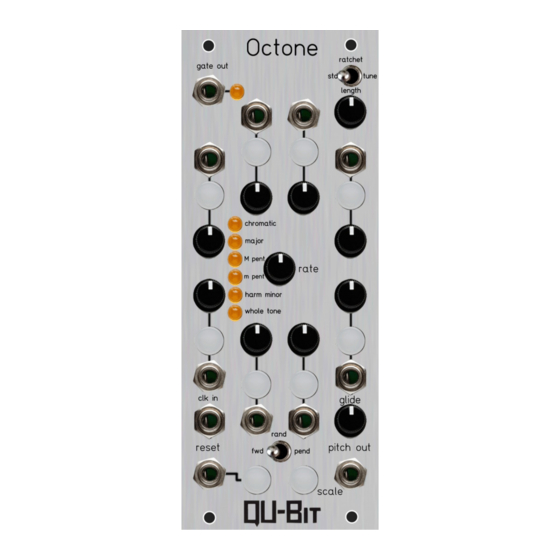
Table of Contents
Advertisement
Advertisement
Table of Contents

Summary of Contents for Qu-Bit Electronix Octone
- Page 1 Octone Pitch and Gate Sequencer...
- Page 2 With the combination of powerful pitch and gate controls, the Octone is the ideal sequencer for crafting tonal melodies with intricate rhythmic patterns. Made by Qu-Bit in Portland, OR...
-
Page 3: Table Of Contents
Table of Contents Installation/Specifications Octone General Functions Overview Enabling and Assigning Ratchets for Individual Steps Holding Notes Chaining Two Octones – 16 Step Duophonic Sequencer Storing Sequence Patterns with Two Octones Understanding Scales and Modes Mode Examples Factory Reset... -
Page 4: Installation/Specifications
12 volts. In most systems the negative 12 volt supply line is at the bottom. The power cable should be connected to the Octone with the red band facing the bottom of the module. -
Page 6: General Functions Overview
General Functions Overview 1. Step One Gate Out: Individual gate output for step one. Gates are 0V-10V. 2. Step One Gate Enable Button: Button that, when pressed, will enable or disable step one's gate output from the summed gate out. If the button is illuminated, a gate will output from gate out for step one. - Page 7 11. Step Four Gate Enable Button: Button that, when pressed, will enable or disable step four's gate output from the summed gate out. If the button is illuminated, a gate will output from gate out for step four. If the button is unilluminated, a gate will not output from gate out for step four. A gate will always output from the individual gate out, regardless of the button state.
- Page 8 Threshold is 2.5V 27. Reset Button: Button that, when pressed, will move the Octone's step position to step one. In tune mode, pressing the reset button will emit a gate from the gate output, allowing the user to accurately tune notes when filters and VCAs are included in the audio path.
- Page 9 35. Mode Toggle: Toggle that switches the Octone's mode. If the mode toggle is left, then the Octone is set to Standard mode (std). Standard mode behaves as a traditional eight step sequencer. If the mode toggle is center, then the Octone is set to Ratchet mode (ratchet).
-
Page 10: Enabling And Assigning Ratchets For Individual Steps
Note: The Octone will save all settings in between power cycles. Holding Notes Double tapping the step gate enable button of any step will make the Octone hold on that step for as long as the button is held down. Gates will still output from gate out at the rate of the internal or external clock. -
Page 11: Chaining Two Octones - 16 Step Duophonic Sequencer
6 pin ribbon cable. The red stripe of the ribbon cable on the secondary Octone must be on the opposing side of the red stripe on the primary Octone. A factory reset must be performed once the two Octones have been connected. (See Factory Reset for more information). - Page 12 Primary Secondary Pitch out on the primary Octone will always output the current knob states. Pitch out on the secondary Octone can output the current knob states, transposed knob states, or stored sequence patterns.
- Page 13 1. (See Storing Sequence Patterns with Two Octones for more information). If the toggle is right, the secondary Octone's pitch out will generate its voltage from the currently selected sequence pattern in bank 2. (See Storing Sequence Patterns with Two Octones for more information).
-
Page 14: Storing Sequence Patterns With Two Octones
If the knob is far left, pulse width will be as wide as possible. If the knob is far right, pulse width will be as narrow as possible. When the primary Octone is set to Ratchet mode, this is the secondary Octone's burst rate control. -
Page 15: Understanding Scales And Modes
Understanding Scales and Modes All modes (Ionian, Dorian, Phrygian, Lydian, Mixolydian, Aeolian, and Locrian) can be accessed from the Octone's Major scale. For instance, C Ionian, D Dorian, E Phrygian, F Lydian, G Mixolydian, A Aeolian, and B Locrian all include the same notes. -
Page 16: Factory Reset
A factory reset will enable all gates, disable all ratchets, assign two ratchets per step, and will erase all saved patterns. To reset the Octone to factory settings, hold down the reset and scale selection buttons when powering up. The scale selection indicators will flash one-by-one from bottom to top.







Need help?
Do you have a question about the Octone and is the answer not in the manual?
Questions and answers